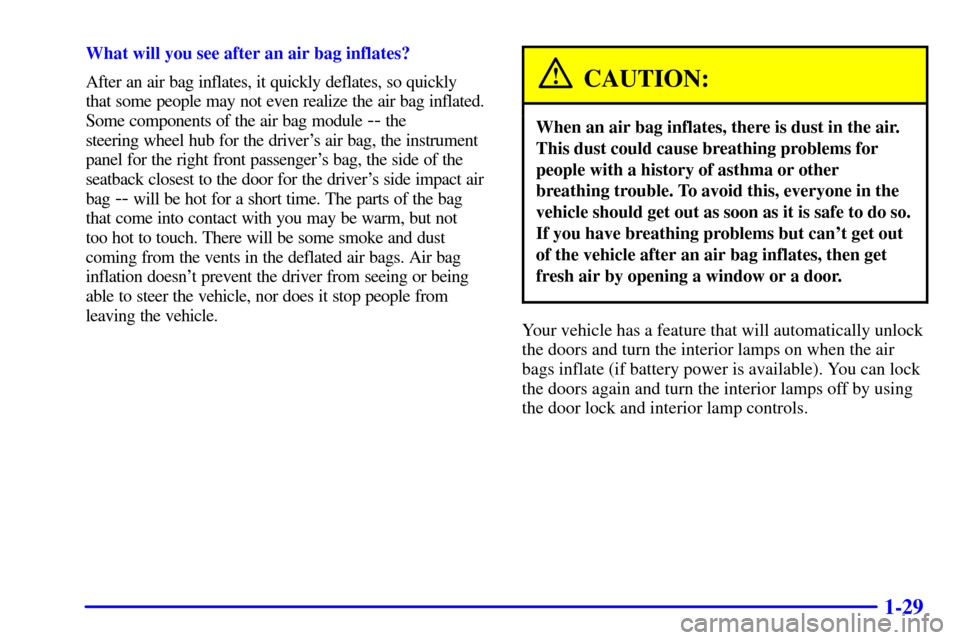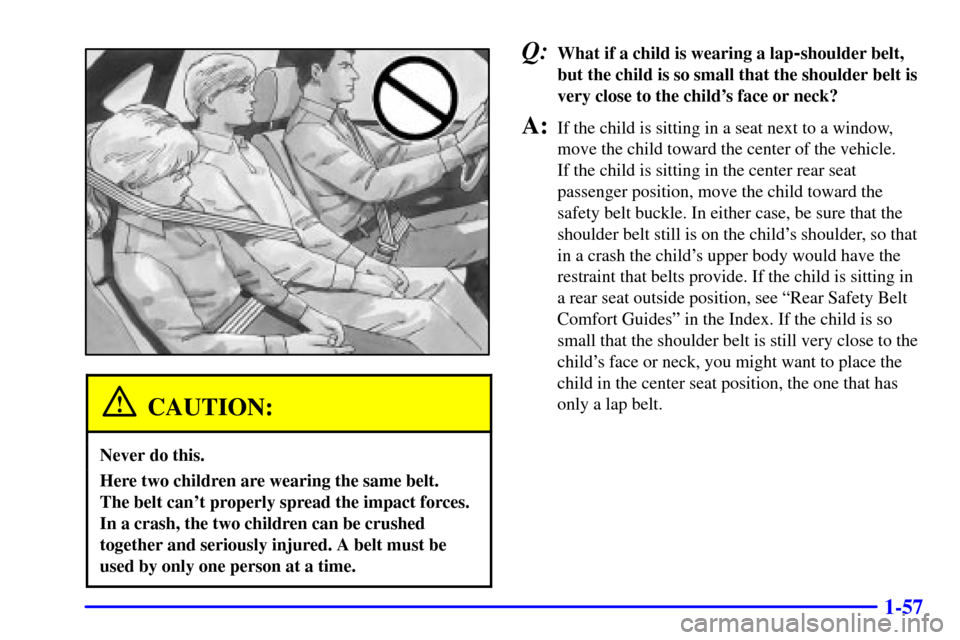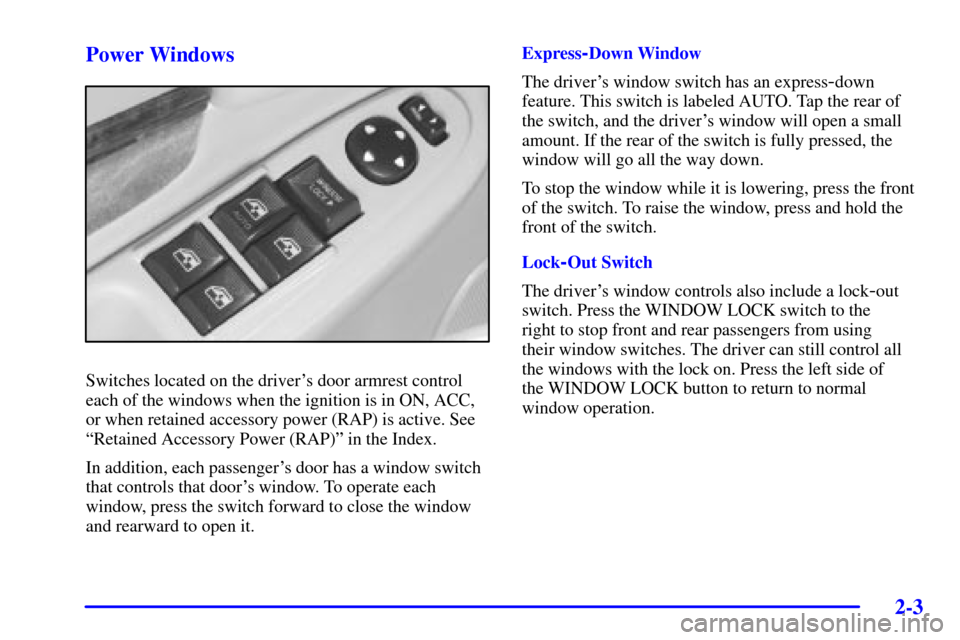Page 35 of 397

1-29
What will you see after an air bag inflates?
After an air bag inflates, it quickly deflates, so quickly
that some people may not even realize the air bag inflated.
Some components of the air bag module
-- the
steering wheel hub for the driver's air bag, the instrument
panel for the right front passenger's bag, the side of the
seatback closest to the door for the driver's side impact air
bag
-- will be hot for a short time. The parts of the bag
that come into contact with you may be warm, but not
too hot to touch. There will be some smoke and dust
coming from the vents in the deflated air bags. Air bag
inflation doesn't prevent the driver from seeing or being
able to steer the vehicle, nor does it stop people from
leaving the vehicle.
CAUTION:
When an air bag inflates, there is dust in the air.
This dust could cause breathing problems for
people with a history of asthma or other
breathing trouble. To avoid this, everyone in the
vehicle should get out as soon as it is safe to do so.
If you have breathing problems but can't get out
of the vehicle after an air bag inflates, then get
fresh air by opening a window or a door.
Your vehicle has a feature that will automatically unlock
the doors and turn the interior lamps on when the air
bags inflate (if battery power is available). You can lock
the doors again and turn the interior lamps off by using
the door lock and interior lamp controls.
Page 49 of 397
1-43
A forward-facing child seat (C-E) provides restraint
for the child's body with the harness and also sometimes
with surfaces such as T
-shaped or shelf-like shields.
A booster seat (F-G) is a child restraint designed to
improve the fit of the vehicle's safety belt system. Some
booster seats have a shoulder belt positioner, and some
high
-back booster seats have a five-point harness. A
booster seat can also help a child to see out the window.
Page 63 of 397

1-57
CAUTION:
Never do this.
Here two children are wearing the same belt.
The belt can't properly spread the impact forces.
In a crash, the two children can be crushed
together and seriously injured. A belt must be
used by only one person at a time.
Q:What if a child is wearing a lap-shoulder belt,
but the child is so small that the shoulder belt is
very close to the child's face or neck?
A:If the child is sitting in a seat next to a window,
move the child toward the center of the vehicle.
If the child is sitting in the center rear seat
passenger position, move the child toward the
safety belt buckle. In either case, be sure that the
shoulder belt still is on the child's shoulder, so that
in a crash the child's upper body would have the
restraint that belts provide. If the child is sitting in
a rear seat outside position, see ªRear Safety Belt
Comfort Guidesº in the Index. If the child is so
small that the shoulder belt is still very close to the
child's face or neck, you might want to place the
child in the center seat position, the one that has
only a lap belt.
Page 67 of 397

2-
2-1
Section 2 Features and Controls
Here you can learn about the many standard and optional features on your vehicle, and information on starting,
shifting and braking. Also explained are the instrument panel and the warning systems that tell you if everything is
working properly
-- and what to do if you have a problem.
2
-2 Windows
2
-4 Keys
2
-6 Door Locks
2
-9 Remote Keyless Entry (If Equipped)
2
-13 Trunk
2
-18 Theft
2
-19 Content Theft-Deterrent (Option)
2
-20 Vehicle Customization Settings
2
-30 Passlock�
2-30 New Vehicle ªBreak-Inº
2
-31 Ignition Positions
2
-32 Starting Your Engine
2
-34 Engine Coolant Heater (Option)
2
-36 Automatic Transaxle Operation
2
-40 Parking Brake
2
-41 Shifting Into PARK (P)
2
-44 Shifting Out of PARK (P)
2
-45 Parking Over Things That Burn2
-45 Engine Exhaust
2
-46 Running Your Engine While You're Parked
2
-47 Tilt Wheel
2
-47 Turn Signal/Multifunction Lever
2
-54 Exterior Lamps
2
-57 Interior Lamps
2
-59 Mirrors
2
-66 Accessory Power Outlet
2
-68 Auxiliary Power Connection (Power Drop)
2
-69 OnStar� System (If Equipped)
2
-73 Power Sunroof (Option)
2
-74 HomeLink� Transmitter (Option)
2
-78 The Instrument Panel -- Your
Information System
2
-80 Instrument Panel Cluster
2
-83 Warning Lights, Gages and Indicators
2
-94 Message Center
2
-103 Driver Information Center (DIC) (Option)
Page 68 of 397
2-2
Windows
CAUTION:
Leaving children in a vehicle with the windows
closed is dangerous. A child can be overcome by
the extreme heat and can suffer permanent
injuries or even death from heat stroke. Never
leave a child alone in a vehicle, especially with the
windows closed in warm or hot weather.
Page 69 of 397

2-3
Power Windows
Switches located on the driver's door armrest control
each of the windows when the ignition is in ON, ACC,
or when retained accessory power (RAP) is active. See
ªRetained Accessory Power (RAP)º in the Index.
In addition, each passenger's door has a window switch
that controls that door's window. To operate each
window, press the switch forward to close the window
and rearward to open it.Express
-Down Window
The driver's window switch has an express
-down
feature. This switch is labeled AUTO. Tap the rear of
the switch, and the driver's window will open a small
amount. If the rear of the switch is fully pressed, the
window will go all the way down.
To stop the window while it is lowering, press the front
of the switch. To raise the window, press and hold the
front of the switch.
Lock
-Out Switch
The driver's window controls also include a lock
-out
switch. Press the WINDOW LOCK switch to the
right to stop front and rear passengers from using
their window switches. The driver can still control all
the windows with the lock on. Press the left side of
the WINDOW LOCK button to return to normal
window operation.
Page 70 of 397
2-4
Keys
CAUTION:
Leaving children in a vehicle with the ignition
key is dangerous for many reasons. A child or
others could be badly injured or even killed.
They could operate the power windows or
other controls or even make the vehicle move.
Don't leave the keys in a vehicle with children.
Page 79 of 397
2-13
Resynchronization
After you have changed the battery in your transmitter,
you will need to resynchronize the transmitter. To do
this, press the LOCK and UNLOCK buttons on the
transmitter together and hold for approximately seven
seconds or until one brief horn chirp is heard.
Trunk
CAUTION:
It can be dangerous to drive with the trunk lid
open because carbon monoxide (CO) gas can
come into your vehicle. You can't see or smell
CO. It can cause unconsciousness and even death.
If you must drive with the trunk lid open or if
electrical wiring or other cable connections must
pass through the seal between the body and the
trunk lid:
�Make sure all other windows are shut.
�Turn the fan on your heating or cooling
system to its highest speed with the setting
on VENT. That will force outside air into
your vehicle. See ªComfort Controlsº in
the Index.
�If you have air outlets on or under the
instrument panel, open them all the way.
See ªEngine Exhaustº in the Index.